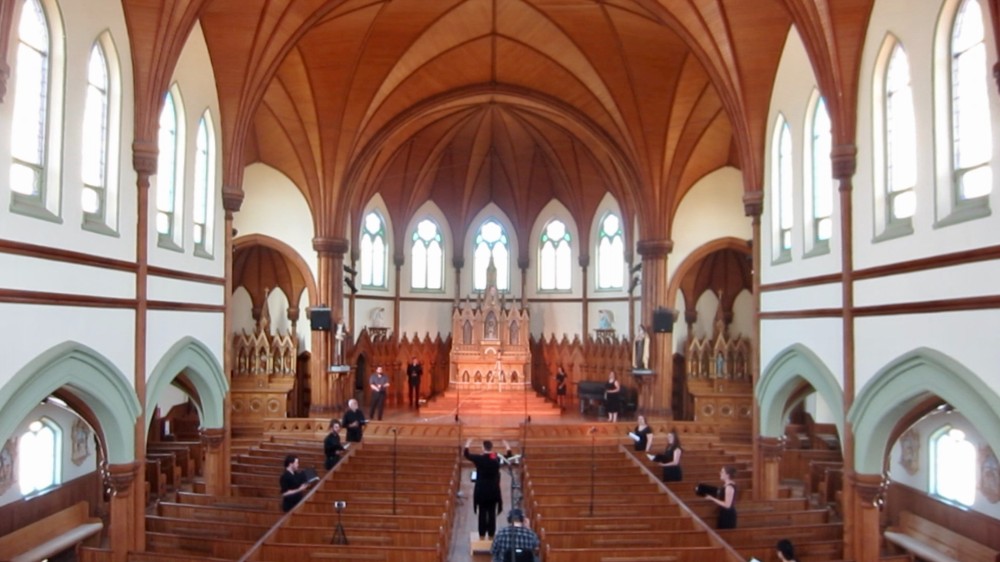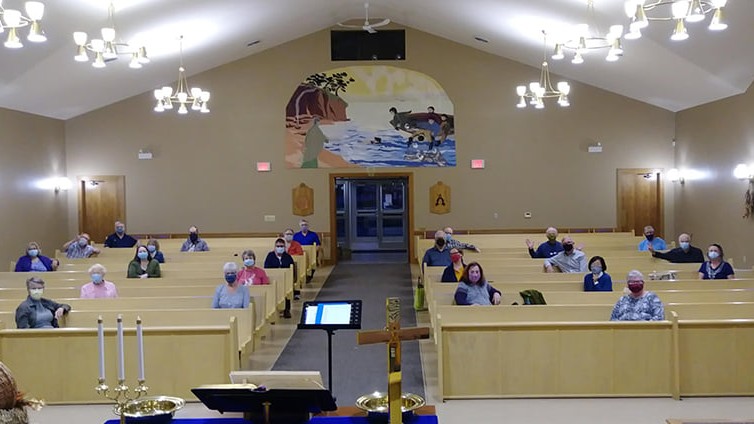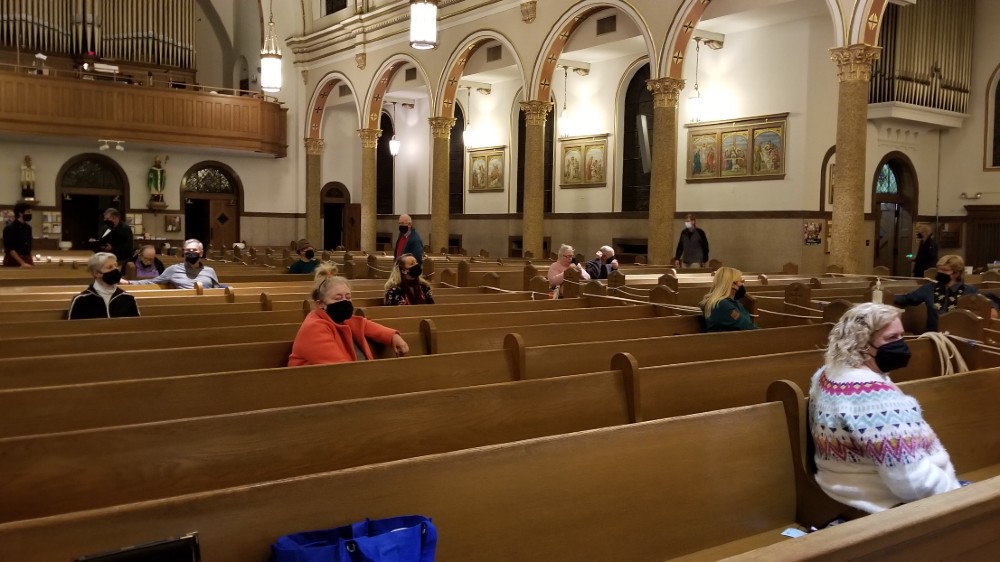
Photo of: Luminos Ensemble
With the pandemic still underway, some community choruses have begun to dip their toes back in the water with in-person, live rehearsals and performances. From drive-in choirs, to outdoor chamber album recordings, to socially-distanced sings at wineries, choruses are getting really creative with the ways they can come together in person while simultaneously mitigating the risks of COVID-19 transmission.
I interviewed a handful of choruses that have returned to in-person rehearsals to hear more about what their decision-making process looked like.
Disclaimer: Live events still carry great risk of COVID-19 presence and transmission which could result in serious injury or death of event participants. This article is not intended to endorse the return to live events. Instead, we continue to disseminate information about what choral organizations are doing around the country/world amidst the pandemic, whether it be virtual, in-person, or otherwise. We encourage all organizations to stay informed with research, science, and data and to consult their local health authorities before planning or returning to live events.
What Types of Data are Choruses Using to Make Their Decision?
The internet can be an overwhelming place of information, and often misinformation too. What data is out there to help choruses make the decision whether or not to return to live, in-person rehearsals? What information is considered reliable in helping to shape these decisions?
Michelle Folta, Artistic Director of the Voices of the Valley Children’s Chorus in Columbus, Georgia, said that before returning to live rehearsals, "you have to know your community and you have to know your COVID-19 numbers and averages in the community. You have to know the arts community and what other people are doing. The arts community in Columbus is very tight — we're all watching and talking amongst each other. It's a lot of detective work, gathering all of the information."
Anneliese Clear, President of Musica Sacra Cincinnati in Ohio agreed on the importance of checking the COVID-19 case counts, "We're looking at our health department's metrics, such as the case count per 100,000 to see if it's a foolhardy risk or if we think we can keep our risk low based on our practices."
The public health ordinances or authorities in each town, city, or state/province will likely have the most accurate COVID-19 case counts. So, that is a good place to start gathering data. The COVID-19 Event Risk Assessment Planning Tool is also a helpful tool in assessing case counts by county and risks on COVID-19 presence by event size. One glance at this map confirms the assumption that geography matters when it comes to risk levels, so it's important to have accurate local data in addition to nationwide data and best practices. After gathering case count information, these choruses have also relied on expert health organizations to lay out specific guidelines and safety precautions for live events, such as the Centers for Disease Control and Prevention (CDC).
Choral organizations are also relying on scientific research on COVID-19 aerosol transmission specifically as it relates to music-making and singing, such as these studies by the Hochschule Für Musik Freiburg, National Federation of State High School Associations, and Oxford Academic. (Often referred to in casual conversations as "the German one," "the Colorado one," and "the Oxford one," respectively.)
Bill Adams, the Founder and Artistic Director of The Fort Bend Boys Choir of Texas was following the trends of boys choirs across Europe. While Europe was getting back to live singing activities, he wanted to learn more about what it might take for American boys choirs to do the same. He said, "I gleaned a lot of information from the research done in England and took as much as I could from CDC in regards to the spacing, masking, circulation, etc. This is more than a safety issue. Yes, safety is paramount. But there's the community, camaraderie, and those intangible things that are so important."
And finally, in order to both stay up-to-date on new data and research as well as glean information about the logistical components of returning to live rehearsals, choruses are leaning heavily on umbrella choral organizations that help disseminate this type of information such as Chorus America, Choral Canada, the National Association of Teachers of Singing, National Association for Music Education, American Choral Directors Association, Chorus Connection, and local choral consortia.
Some local arts councils and choral consortia are even getting involved by helping put together event guidelines, as such is the case with the Missouri Arts Council via their "ArtSafe" certification program.
"We were determined not to let the music die. A couple [of our staff members] got certified with Missouri ArtSafe so we could figure out how to perform safely. Their guidelines were really helpful," said William Baker, Founder and Director of The Choral Foundation in Kansas City, Missouri.
Of course, gathering research and data is only half the battle. The trickier part, perhaps, is convincing yourself and your team that meeting in person is worth the risk.
On Putting Together an Operational Plan & Getting Buy-In
"It took a great deal to convince the board at the church first. Then I had to convince the [chorus's] board to let me take it to the parents. Then I had to convince the parents! This is scary stuff so a lot of parents were very reticent. But they see the value of this, that it's more than just music," exclaimed Adams.
For any choral organization, there is most likely a large range of opinions and feelings within the choral membership. As recent experiences have told us, even something as simple as whether you should wear a mask is often debated with great passion from every side. So one can only imagine the immense hurdle it must be to make a decision to return to live rehearsals with so many factors to consider, risks to assume, and people to hear. I wondered, who is involved in these conversations and what do these conversations look like?
"We have great admiration for the work that people have done with virtual choirs. The time, energy, and resources it takes are enormous. Our board looked at that as an option. COVID is a terrible crisis but a temporary crisis and we would rather put our resources towards finding a way to do what we can do now and preparing for the day these veils are lifted and we can return quickly," said Baker. "We do have a large organization with health professionals, hospital executives, etc. in our membership. We met [with them] for a planning session and we said 'we want to resume rehearsals, how do we do it?' They reviewed the plan and we had them sign off on the plan."
Amy Desrosiers, Choir Manager and singer with the Capital Chamber Choir in Ottawa, Canada also utilized their membership in the decision, "We did assessments with the church to make sure it's good for ventilation and discussed what we can do to make it as optimal as we can. We consulted within our choir too — we have doctors and lawyers who provided us with guidance. Your resources are right there, use them!"
In order to get approval with venues, the boards, the singers, the parents, etc. a lot of legwork had to first go into developing a sample operational plan and then getting the decision-making team to sign off on that plan. An operational plan can include all of the necessary precautions a chorus plans to take to mitigate risks and the plan can then be used to pitch ideas to the collaborating venues, board, and public health authorities.
These operational plans include information such as:
- Ventilation measures, time limits, and/or air recirculation protocols
- Entry/exit markings
- Sanitizing measures and hand-washing stations
- Mask requirements
- Temperature and symptoms monitoring
- Spacing between participants and social distancing protocols
- Liability waivers and information
Dr. Margot Rejskind, Artistic Director of Luminos Ensemble and several other ensembles in Prince Edward Island, Canada elaborated, "I wrote the operation plan that includes information such as the number of singers we planned to have, how we will make sure they stay distanced, where we will provide hand-washing stations, how we will clean, etc. We drew a diagram of how we would be laid out in the church. And we created a communication plan for our members communicating as clearly as we can and letting everyone know what their responsibility is. We then had to get it approved by public health."
Desrosiers did something similar with her choir, "We do have protocols in place. Ottawa Public Health outlined the plans and measures we need to take when [singers] arrive on site — thermometer scans, sanitizing stations, disposable masks, kleenex, sanitizer, and gloves. And actually have tape on the floors of the church to follow which directions they are walking — heading towards the altar or heading back outside. We set up seating plans 8 feet apart. The conductor has a microphone and earpiece so he can hear us. He has a plexiglass screen because we are all singing at him. We explored different ways for ventilation to be optimal. And prior to rehearsal, [our singers] had to sign a waiver to show that they understand the protocols we have in place."
Folta also shared bits from their operational plan for their outdoor rehearsals which take place in a parking garage, "We created a COVID-19 policy that I took from looking at other choirs that I respect in the nation. Parents had to sign a COVID-19 agreement. We created a pre-screening form that every week kids and staff had to complete before they can come into rehearsal. They are met by a staff member when they arrive to make sure they do that, they check their mask, and send them up to [rehearsal] — it's like having a bouncer! We have a policy if a kid gets sick, we notify the choir. We even have contingency plans if I get COVID."
On Putting Together a Singer Communications Plan

Photo of: Summerside Community Choir
As part of the operational plan or in addition to it, most choruses also had some type of communications plan as well to ensure their singers were informed of the new protocols and, in some cases, were even asked to formally agree to them.
A communication plan might include:
- The full details of the operational plan so singers understand every protocol being following
- Singer requirements for self-reporting any positive COVID-19 cases to the organization
- Protocols the organization will follow upon any report of positive COVID-19 case
- Emergency contact information
- Contact tracing protocols
- Expectations for singers to self-monitor symptoms; information about pre-rehearsal symptoms check; verification that they haven't traveled and have not been asked to self-isolate
- Mask requirements, social distancing requirements, touchless protocols, and other safety precautions to be taken at rehearsal
- Setting singer participation expectations
Some choral organizations even take this a step further and coordinate with local health organizations for contact tracing and COVID-19 tracking purposes. According to Desrosiers, in Ottawa there is a COVID-19 tracking app with which residents can report positive COVID-19 cases. The app can alert people who have been in contact with someone who was exposed and ask them to do a self-assessment and/or self-isolate. Desrosiers includes information about the app in their member materials and encourages singer to self-report there.
She said, "On behalf of the choir, we set up a document that outlines the steps to follow if someone got COVID-19. We have a list of emergency contacts and we provided a link to the app. We have internal communications too. If someone contracted it they'd have to tell the emergency contacts, myself and the chair, and then we would send out announcements encouraging singers to isolate, get tested, and trace where they've been."
Key to the communications plan is really setting or resetting singer expectations about their presence in rehearsals and how their health plays a role.
"It's totally volunteer, that was our rule. No one is compelled to participate, it's a 100% voluntary effort," clarified Clear. "If people feel sick or have been around sick people, they stay home. If they feel they have been exposed, they stay home. And we do temperature checks when they get there."
Baker agreed, "We have a policy: if anyone comes to rehearsal and our staff feels like they don't look right, any sign of cough or paleness or anything like that, we send them home. Let's say someone says that they tested positive, we would shut rehearsals down for two weeks and notify our members. If a concert has been announced and if, for some reason, something unfortunate happened, we would cancel the concert."
The Upsides
It seems unlikely that choral organizations would assume these risks unless there were some significant upsides to meeting in person again. Those of us in the arts know how important our work is. But it's weighing those benefits against these serious risks that makes the decision so incredibly difficult and heartbreaking.
“You get a variety of reactions from people. Some people are not freaked out at all. Some people are still freaked out. But tears were flowing when we sang together again. People are so appreciative for being able to sing real music with real people in a real situation. Obviously singing virtually is not as satisfying experience. Many appreciated us being able to provide options. Those that do participate virtually are still full members of the chorus. It’s a no-judgment zone, they are welcome to do that," said Baker. "All of us have mixed emotions. I have some weeks myself where I'm worried, but every week that goes by the confidence grows."
Others expressed the sheer joy it brought their singers.
"Gosh that first rehearsal… there were boys crying they were so happy to be back together," said Adams.
Clear agreed, "We're just all so happy to be singing again, we don't care if it's in a hazmat suit."
And in the case of one of Dr. Rejskind's choirs, her membership has doubled in size. She said, "We picked up a lot of people in other choirs that aren't meeting."
Suggestions for Choruses Looking to Rehearse Again In Person

Photo of: Musica Sacra Cincinnati
The choral Facebook groups are already exploding with people beginning to talk about the return to in-person rehearsals. And while, it may not be the choice for many, some will be returning again soon. I asked the choruses to share some of their suggestions for choruses that are looking for advice on staying safe upon their return to live rehearsals.
Talk to the public health officials in your area.
Dr. Rejskind said this is of the utmost importance! She reiterated, "I did advocacy with our public health folks earlier in pandemic. We were the first to go send an email and say, ‘we want to talk.’ I had a big hand in writing regulations. Because of that, here [the guidelines are] very clear, this is how its going to be. In some areas they are not allowed to do trip trills. That is something that has specifically been outlawed."
She continued, "For us, the real door opener was that [the public health officials] allowed something else to happen. They allowed public performance to happen and they were opening gyms but not allowing singing. But, I said, ‘look, if this is safe then singing is safe. If singing is not safe, then that’s not safe either and either way, I’d like to get clarity.’ Because of that they actually tightened up stuff in the gyms but they also were open to the idea of finding us a safer way forward."
Be smart, be flexible, be brave.
"The mask thing has gone better than I thought it would. It's not ideal, but not a deal-killer at all. I was pleasantly surprised how the masks worked. Don’t fear the masks - [your singers] can sing through the masks! There are also advantages of having a sense of spaciousness: it’s harder to get unity and clarity in enunciation but working in that environment has increased skills in that area," said Baker.
"The theme of this season has been adjustments, adjustments, adjustments, adjustments. We’ve spent a lot of it this time reflecting on what has and hasn’t worked and how to we adjust safely. The board and our music director had weekly meetings to discuss developments with Ottawa Public Health and how we would adjust," said Desrosiers.
"One of the things that has gotten me through COVID is this whole idea of grit. You can't just sit at the bottom of a mountain and cry. You have to find a stick and dig to the top," said Folta.
She continued, "What we do is a human connectivity craft and without that element, it’s missing. It’s hollow. When schools went back, I was starting to get questions from parents to see when we would come back. We were doing community connection events [online] to see everyone socially connected, trivia night and stuff like that, but there were murmurings that our choir was not happy. It’s the hardest thing for a choir director to admit to but the most healthy thing you can do is know when your choir isn’t happy. I didn’t know how long we could maintain a positive balance. With school openings and doing a great job of maintaining protocol, we knew we could attempt it. It was a terrifying process for me. I've never had to think of my job from a life or death perspective. I've never had to think of it as endangering the lives of children, that's just against everything we are. So it was always going back to research, confirming [everything we do] with science and research, and planning logistics where we could stay safe."
"We're going strong and safely. We're all scared to death. I’m still scared to death but I really thought and now I know we can do this safely," said Adams.
“I understand why people are wary. It’s an unprecedented time. The thing I would say to encourage all of us is to understand that we have taken extraordinary measures for an extraordinary event but they are temporary. This is not the new normal. This is a temporary thing that will go away. This will go away. And when it goes away, we want to be ready to bust out of the gate," exclaimed Baker. "I would encourage everyone to stick to their comfort level and the capacity they have. I encourage everyone to follow every protocol and apply every level of uncompromising safety to mitigate risks.”
He continued, "Let's not be judging of anyone. Let's pray for them and champion them on. If a group is saying we're taking [the year] off, let's give thanks for the decision they’ve made and pray for their future success. We are all in this together. Just as the researchers and the responders are first responders for health, musicians are the first responders for the soul and spirit. The work choral people do is essential. It is not an addendum, it is essential in whatever form we can bring it."
Summary
The pandemic is still afoot. Meanwhile, choruses continue to experiment with innovative ways of singing together. One thing is certain: there is no one-size-fits-all solution to choral singing right now.
Live events perhaps carry the greatest health and safety risks and the decision to return to live rehearsals and performances should not be taken lightly. It's important to note that the risks also greatly differ geographic locations and the makeup of each chorus's membership.
In our season planning ebook, we encouraged each choral organization to carefully consider and analyze the risks and to discuss that with your choral leadership. We cannot make the decision for you, but for now, we encourage you to stay informed of the science and data, mitigate risks whenever possible, and always stay connected.
Resources:
The interviewed organizations have kindly offered public access to the handbooks, protocols, and procedures they have put in place for their organizations. They offer these as resources for other choral organizations looking to get started with in-person performances.
All documents provided are for information only. Please seek independent legal advice to determine content that would be suitable for your organization and for the conditions in your area.
- Choral Foundation Protocols for Rehearsals & Concerts - provided by William Baker Choral Foundation
- Example COVID-19 Waiver and Protocol - provided by Capital Chamber Choir
- Summerside Community Choir COVID-19 Operational Plan - provided by Summerside Community Choir
- Example Venue Waiver/Release - provided by The Fort Bend Boys Choir of Texas
- Example Singer Waiver/Release - provided by The Fort Bend Boys Choir of Texas
- Sample Floor Plan: St. Boniface Catholic Church - provided by Musica Sacra Cincinnati
- Musica Sacra Cincinnati Fall Rehearsal Protocols
Acknowledgments:
- Dr. Margot Rejskind, Artistic Director, Luminos Ensemble, Summerside Community Choir, and FORTE Men's Choir (Prince Edward Island, Canada)
- Amy Desrosiers, Choir Manager and Singer, Capital Chamber Choir (Ottawa, Canada)
- Michelle Folta, Artistic Director, Voices of the Valley Children’s Chorus (Columbus, Georgia, USA)
- Bill Adams, Founder and Artistic Director, The Fort Bend Boys Choir of Texas (Stafford, TX, USA)
- Anneliese Clear, President, Musica Sacra Cincinnati in (Cincinnati, Ohio, USA)
- William Baker, Founder and Director, The William Baker Choral Foundation (Roeland Park, Kansas, USA)
- Laura Baker, Development Director, The William Baker Choral Foundation (Roeland Park, Kansas, USA)

Tori Cook is the former Director of Sales & Marketing at Chorus Connection, an active board member of the Greater Boston Choral Consortium, and a soprano with the Tanglewood Festival Chorus. In a past life, she was the Music Director of the Harborlight Show Chorus and President of Chorus pro-Musica. When not making music, she daydreams about adopting a golden retriever puppy and scuba diving to exotic locations around the world.

